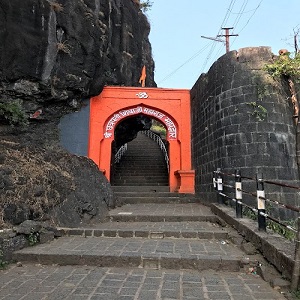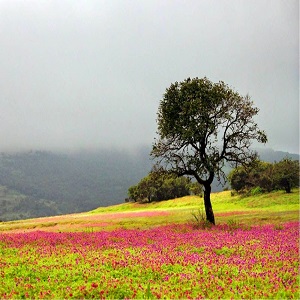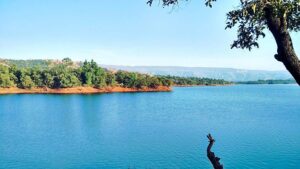Pune To Kass Pathar Cab
Sajjangad

From Pune to Sajjangad Distance is just 128 km. The name of Shri Samarth Ramdas Swamy comes to mind as soon as the name of Sajjangarh fort is mentioned. Sajjangarh is a beautiful fort situated in the Parli valley in the lap of Sahyadri. Sajjangarh fort is located in the Parli valley of the Satara district. Shilahar Raja Bhoj built this fort in 11th century. To the west of this Sajjangad is the village of Chiplan, to the north is Mahabaleshwar, Pratapgad, and Raigad, to the south is Kalamb and to the north-east is the city of Satara and Ajinkyatara.
Chhatrapati Shivaji Maharaj had won this fort from Adil Shah on 2 April 1673. And on the request of Chhatrapati Shivaji Maharaj, Samarth Ramdas Swami Sajjan came to the fort for permanent residence. And since then the name of this fort came as “Sajjangard”. Sajjangarh is about 10 kilometers from Satara city. This fort has gained cultural importance due to the residence of Samarth Ramdas Swami.
There are steps to climb Sajjangarh while climbing these steps you can see the temple of Kalyan Swamy. Moving forward, there is a Maruti temple on one side and a Gautami temple on the other side. On the left side of the entrance is the temple of Anglai Devi. There is a Ram temple on Sajjan Gada. In this main temple you can see idols of Rama, Lakshmana and Sita. There is a tunnel on the Sajjan Fort. In this tunnel, Samarth Ramdas Swami’s Samadhi is located and in the box, there are the feet of Dattatreya. So you should definitely visit this Sajjangad at least once Just Call Us and Book A Cab.
Kaas Pathar

Valley of Flowers is the name of Kaas platear in Satara city of Maharashtra. It is equivalent to the famous Valley of Flowers of Uttarakhand in Maharashtra. Kas Platear is a plateau near Satara. It is a high hilly plateau and the grasslands turn into a ‘valley of flowers’ during the rainy season, especially from August to early October. The Kas Plateau has 150 or more species of flowers, shrubs and grasses.
There are two ways to reach Kaas. A direct route from Satara and a link road connecting Mahabaleshwar and Pachagani to Kaas Pathar from Tapola.
Legend has it that the name Kaas came from the presence of the Kasa tree here. There is a temple of Kasai Devi, the village deity, in Kaas village. The characteristic of the kaas tree is that its leaves appear blood-colored after ripening. It bears clusters of white flowers with red petals for just 15 days in the month of March. But the real beauty of Kaas Pushpa Plateau blooms in the month of September. Kaas Plateau is a low-soil volcanic plateau of sheared rock.
More than 400 species of flowers are found here. More than 850 species of plants are found in total. It also includes endemic, rare plants. To visit Kaas Pathar Book A Cab and also visit near places. There are so many places to be near, also it is the Best Weekend destination to visit with your family.
Koyna Backwater

Koyna Dam is one of the largest dams in the state of Maharashtra and is located at Koyna Nagar in Satara district. It is built on the river Koyna, a major tributary of river Krishna and is one of the major places to visit in Satara. The beauty of the dam is at its best during monsoons and creates an extraordinary atmosphere that must be experienced once. However, it looks beautiful throughout the year and invites travelers from all over to admire its beauty.
The Koyna Dam is a rubble-concrete structure built on the Koyna River, which originates at Mahabaleshwar, a high resort in the Sahyadri ranges. The main purpose of the dam is to generate hydroelectricity, as well as to create some irrigation facilities in the surrounding districts. The Koyna Dam supplies water to the western part of Maharashtra, as well as hydroelectric power to the surrounding area.
Satara Ajinkyatara Fort

Ajinkyatara Fort is situated on Ajinkyatara Hill in the historic city of Satara in Maharashtra. This fort was built by Raja Bhoja of Schiller family. It is at an altitude of 3000 feet and 1006 meters above sea level. It is located in Sangli district. It is also known as “Sapta Rishi” fort. We see Ajinkyatara standing with a tower in the hill range of Satara district of Maharashtra. This fort,can be seen from anywhere in the entire city of Satara. It is also known as ‘Fort of Satar’.
Ajinkyatara mountain is on the “Bamanoli” mountain range which starts from Pratapgad. The geographical importance of all these forts is such that it is impossible to reach here by traveling directly from one fort to another. All the other forts in this area are built at a relatively low height of Ajinkyatara. Ajinkyatara was the fourth capital of the Marathas.
The special feature of this fort is that it also has seven water ponds, which fill up completely during monsoons. There are many idols carved on stone. A big strip called Ajinkyatara is also installed near it. From here you can easily see Chandan Vandan Fort and Jarandeshwar Hill. Chhatrapati Shahu Maharaj built a city at the foot of this fort in 1721 and moved his capital from the fort to land for the first time.

